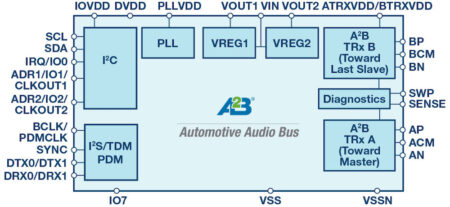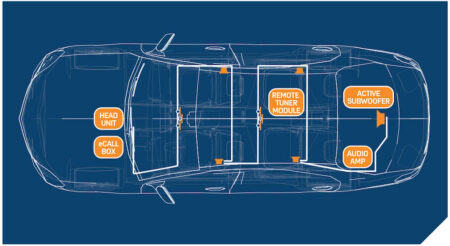Innovative Digital Bus Architecture Reduces Audio System Costs
Car manufacturers strive to make future generations of vehicles safer, smarter, and more fuel efficient than their predecessors. To accomplish this, electronic systems continue to increase in number and complexity as more electronic control units (ECUs) are deployed in the vehicle, enabling new features and capabilities such as smart radio connectivity, road noise cancellation (RNC), personal audio zones (PAZ), in-car communications (ICC), and autonomous driving. As the number of ECUs increases, so does the weight and cost of the required cabling harnesses that provide connectivity between the various ECUs. This added weight, in turn, decreases the fuel efficiency of the vehicle, much to the chagrin of car manufacturers.
Car manufacturers must balance their desire to deliver advanced, feature-rich infotainment systems with the need to comply with government imposed fuel efficiency standards. Reducing the weight of existing cable harnesses can lead to significant improvements in fuel efficiency.
Current Landscape
Traditionally, automotive audio ECUs have been connected by either individual analog cables or existing digital bus architectures—both of which present limitations, inefficiencies, and unnecessary expenses. Car audio systems that use analog wiring require dedicated, expensive, shielded cables for each audio signal or channel. In today’s premium audio systems, by supporting multichannel (5.1 or 7.1) Dolby or DTS decoding, the number of required cables rapidly increases. Additionally, the required analog-to-digital converters (ADCs) and digital-to-analog converters (DACs) increase total system cost while introducing potential areas of audio performance degradation.
Digital bus standards such as MOST® or Ethernet AVB have been widely adopted in current generation infotainment systems because they greatly simplify the wiring complexities associated with analog implementations. However, the added performance and flexibility of MOST and Ethernet
AVB carry the added cost of expensive microcontrollers to manage their associated software protocol stacks. Additionally, these digital bus architectures are inherently nondeterministic with variable system delays from node to node. This fundamental flaw in existing digital bus architectures is not acceptable for latency-sensitive speech and voice-based applications, such as ANC/RNC and ICC.
Introducing the Automotive Audio Bus
The Automotive Audio Bus® (or A2B) ® is an innovative and application tuned technology from Analog Devices that is proven to reduce the weight of cable harnesses by up to 75% while delivering high fidelity digital audio. A2B is optimized for audio applications delivering superior audio quality relative to analog connectivity at significantly lower total system cost than existing digital bus standards. In its simplest form, A2B is a high bandwidth (50 Mbps) digital bus capable of transporting I2S audio and I2C control data together with clock and power using a single, 2-wire, unshielded, twisted pair cable over significant distances—up to 15 m between nodes and 40 m over the entire daisy chain.
Automotive Audio Bus Basics
From an implementation standpoint, A2B is a single master, multiple slave line topology. The AD2428W, together with two feature-reduced, lower cost derivatives—AD2427W and AD2426W—comprise the latest family of pin-compatible, enhanced A2B transceivers. These latest product introductions support the daisy-chaining of a single master, plus up to 10 slave nodes, which represents a 20% increase relative to first generation A2B offerings, as seen in Figure 1. This daisy-chaining capability allows a maximum A2B distance of up to 40 m, with up to 15 m supported between individual nodes. Using a line topology instead of a ring topology is an important element of the A2B technology related to overall system integrity and robustness. If one connection of the A2B daisy-chain is compromised, the entire network does not collapse. Only those nodes downstream from the faulty connection are impacted by the failure, while the embedded diagnostics inherent to the A2B technology are able to isolate the source of the failure, signaling an interrupt to initiate corrective action.

Figure 1. A2B automotive audio transceiver functional block diagram.
The A2B master-slave line topology is inherently efficient when compared to existing digital bus architectures. After a simple bus discovery process, zero additional processor intervention is required to manage normal bus operation. As an added benefit of the unique A2B architecture, system latency is completely deterministic (2-cycle delay) irrespective of the audio node’s position on the A2B bus. This feature is extremely important for speech and audio applications, such as ANC/RNC and ICC, where audio samples from multiple remote sensors must be processed in a time-aligned fashion.
The AD2428W, AD2427W, and AD2426W A2B transceivers deliver audio, control, clock, and power over a single, 2-wire, UTP cable. This reduces overall system cost for a variety of reasons:
- The number of physical wires is reduced relative to traditional implementations.
- The actual wires themselves can be lower cost, lower weight UTP as opposed to more expensive shielded cables.
- Most importantly, for particular use cases, the A2B technology offers a phantom power capability that delivers up to 300 mA of current to audio nodes on the A2B daisy-chain. This phantom power capability eliminates the need for local power supplies at the audio ECU—further reducing total system costs.
The total 50 Mbps bus bandwidth delivered by the A2B technology supports up to 32 upstream and up to 32 downstream audio channels using standard audio sample rates (44.1 kHz and 48 kHz) and channel widths (12-bit, 16-bit, 24-bit). This provides significant flexibility and connectivity to a wide range of audio I/O devices. Maintaining a completely digital audio signal chain between audio ECUs ensures the highest quality audio is preserved without introducing the potential for audio degradation via ADC/DAC conversion.
As described earlier, system-level diagnostics are an essential component of the A2B technology. All A2B nodes have the capability to identify a variety of fault conditions including opens, wires shorted together, wires reversed, or wires shorted to power or ground. This capability is important from a system integrity standpoint because in the case of opens, wire shorts, or reversed wire faults, A2B nodes are still fully functional upstream of the fault. The diagnostic capability also provides for the efficient isolation of system-level failures, which is critically important from the dealer/installer standpoint.
Designing an A2B enabled system is greatly simplified using the SigmaStudio™ graphical design environment—the same development tool that supports the Analog Devices SigmaDSP® and SHARC® processor families. SigmaStudio provides the capability to initialize an A2B network and configure all registers via a user-friendly, industry-leading tool chain. An A2B bus bandwidth calculator and a bit error rate test (BERT) are also included within the SigmaStudio environment. A broad array of full featured evaluation systems is available to quickly prototype an actual A2B network to facilitate early system proof of concept, test, verification, and debug.
Target Markets and Applications
A wide variety of markets, both mature and emerging, will benefit from the efficiencies offered by the A2B technology. Target applications include:
- Audio ECU (head unit and premium audio amplifiers) connectivity
- Microphone arrays for hands-free/speech recognition/in-car communications
- Active noise cancellation, road noise cancellation
- Personal audio zones/active speakers
- eCall and telematics systems X Autonomous driving systems X Self-parking systems
- Vital signs monitoring
- Smart radio connectivity
Audio ECU connectivity is an attractive, mature application area where A2B has already been deployed in production vehicles. In a simple example, as seen in Figure 2. where a head unit connects to a premium trunk amplifier, A2B removes the need for individual wires for multichannel audio, plus NAV, cellphone, and chime. A2B replaces all of these wires with a low cost, single 2-wire UTP cable that has been tested and confirmed to pass the most stringent automotive EMC- and EMI-compatibility requirements.

Figure 2. Example of an A2B system in a car.
Efficient and cost-effective microphone connectivity is a design priority driving a variety of use cases and applications. Bluetooth® connectivity and hands-free/speech-recognition systems are standard equipment and eCall systems are already mandatory in some regions. The trend from the OEM standpoint is to move toward multimicrophone (two to four) systems configured individually or as modules. In either case, a system that uses A2B technology has a significantly lower overall system cost when compared to analog connectivity, especially in multimicrophone arrays. Each A2B transceiver can support up to four PDM-input microphones, eliminating the need for three of the four microphone wires in a 4-microphone array.
Road noise cancellation is a derivative of the broader ANC application area and is now under investigation by many auto manufacturers. In wideband ANC, tones harmonically related to a reference input, as well as some nonharmonically related or random tones, can be cancelled. These reference inputs are typically supplied via accelerometers physically distributed around the vehicle—most often in the four wheel wells. Additional inputs to the wideband ANC system would come from error microphones, distributed about the inside of the vehicle with one required for each passenger quiet zone. A traditional implementation uses dedicated analog connections from each accelerometer/microphone to the wideband ANC processing unit. Clearly, this approach can be prohibitive in terms of both wiring cost/complexity as well as connector area on the processing unit. All of these issues are resolved using an A2B implementation.
A2B can also be considered an enabling technology for emerging applications that demand cost-effective sensor connectivity. Applications such as autonomous driving, vital signs monitoring, and self-parking systems, targeting production dates in 2020 and beyond, can all benefit from the features, capabilities, simplicity, and time to market benefits offered by the A2B technology.
Summary
A2B is a digital bus architecture that provides an optimized feature set, performance level, and system cost for wiring intensive audio and control applications.
- A2B delivers superior audio quality relative to analog connections while providing the scalability of more costly digital bus architectures.
- A2B provides a low risk solution in a wide variety of automotive applications.
- A2B-based systems have been deployed since 2016, with over 2M systems already shipped.
- The AD2428W, together with the feature/cost reduced derivatives AD2427W and AD2426W, represent the latest evolution of feature-enhanced A2B transceivers with a planned roadmap to higher integration and performance.
Ken Waurin
Marketing Manager
Analog Devices, Inc.
About the Author
Ken Waurin is a strategic marketing manager at Analog Devices, where he is responsible for automotive infotainment systems. His main interests are premium audio, active noise cancellation, and connectivity. He can be reached at kenneth.waurin@analog.com.




